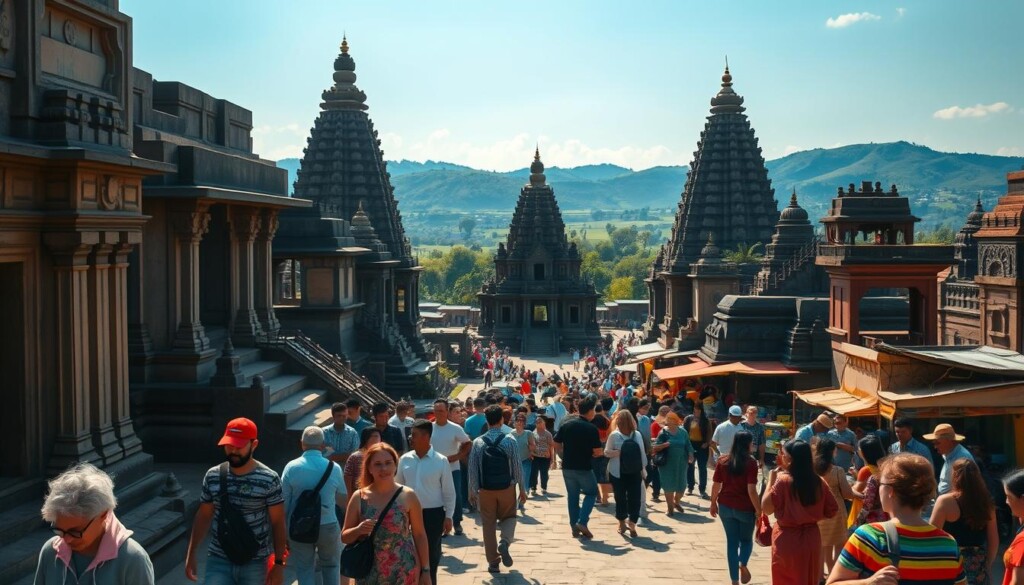What secrets hide beneath the ancient stones of temples? These structures are more than just architectural wonders. They represent the spiritual and artistic views of ancient civilizations. Each temple has its own story, showing the culture and architecture of its time.
By exploring these historical sites, we learn about the societies that built them. We see their artistic skills and the religious ways that shaped their lives.
Key Takeaways
- Ancient temples embody the artistic and spiritual values of their cultures.
- Understanding temple architecture enhances appreciation of historical societies.
- Temples reveal insights into the religious practices of past civilizations.
- The cultural significance of temples transcends mere construction.
- Exploring these structures offers a journey through time and belief systems.
- Temple architecture reflects the technological advancements of the era.
Introduction to Temples and Their Significance
Temples are more than just buildings. They hold deep cultural and spiritual value in many societies. They are places for worship, learning, and socializing, showing the bond between faith and community.
The Role of Temples in Various Cultures
In many cultures, temples are sacred spaces that connect people to their faith. They shape community identity and preserve cultural heritage. Through history, temples have been centers for education, refuge, and rituals. They bring people together, sharing beliefs and traditions.
Architectural Styles of Temples
Temples have different architectural styles, each showing the culture it represents. For example, Indian temples are known for their detailed carvings and colorful sculptures. Greek temples, with their classical design, symbolize beauty and harmony. These styles show temples as symbols of cultural expression and art.
Spiritual and Community Functions
Temples are more than their looks; they are vital for spiritual and community life. They offer spaces for worship, reflection, and community gatherings. Through rituals and events, they strengthen social bonds and collective identity. Visiting temples can help find spiritual guidance or community support. For more information, check out LocalZ.
Prominent Ancient Temples to Visit
Exploring famous historical temples shows us the rich culture, architecture, and spirituality they hold. Each temple is a window to the past, with its own unique style and history. These temples are not just tourist spots but also help us learn about ancient civilizations.
The Parthenon in Greece
The Parthenon is a prime example of Greek architecture. Dedicated to Athena, it shows the artistic and cultural heights of ancient Athens. Built in the fifth century BC, it stands for beauty and harmony.
Its iconic columns and detailed sculptures attract many. They highlight the temple’s importance in ancient Greek worship and civic pride.
Angkor Wat in Cambodia
Angkor Wat is the largest religious monument in the world. It showcases Khmer architecture and Cambodia’s spiritual heritage. Originally a Hindu temple, it later became a Buddhist site, reflecting cultural changes.
Its detailed carvings and vast layout make it a key historical site in Southeast Asia. Its preservation allows us to continue exploring its engineering and artistry.
The Temple of Karnak in Egypt
The Temple of Karnak is a major religious complex in ancient Egypt. Dedicated to the sun god Amun, it features massive columns and statues. It shows the Egyptians’ architectural skill.
It draws historians and tourists who want to see its courtyards and hieroglyphics. These tell stories of devotion and power, showing its importance in ancient Egyptian life.
Temples and Their Historical Context
Throughout history, temples have been key centers of power and authority. They reflect the societal structures of their time. These structures are more than places of worship; they show the link between spirituality and leadership.
Temples as Centers of Power
Temples were important institutions where politics, religion, and economy met. Rulers used them to show their divine right to rule. They were both places of worship and centers for making important community decisions.
The Evolution of Temple Architecture
The history of temple architecture is a story of growth from simple shrines to grand buildings. New technologies and designs led to more complex structures. As building skills improved, temples became symbols of cultural pride and achievement.
Cultural Influences on Temple Design
Local traditions and beliefs greatly influenced temple design. Each culture added its own style and ideas, leaving a unique mark. The variety in temple designs shows how local customs and history shaped spiritual expression over time.
The Connection Between Temples and Community
Temples are key in their communities, acting as centers for many social activities. They help keep communities together and preserve cultural traditions. These places are not just for worship but also for gatherings and events that build community ties.
Temples as Social Hubs
Temples host workshops and community meetings, boosting social interaction. They are spaces where people come together, share stories, and work on projects. The bond between community and temples grows stronger through these activities.
Rituals and Festivals Around Temples
Rituals and festivals at temples unite people, creating shared experiences. These events showcase the area’s cultural richness and strengthen social bonds. They bring diverse groups together, highlighting temples’ role in today’s society.
Modern-Day Relevance of Ancient Temples
Ancient temples remain important today, blending old traditions with new needs. They are hubs for community, culture, and learning. As people look for places that connect with their heritage, temples’ importance in community life increases. For more information, check out a directory of local temples and spiritual.

Exploring Local Temples and Spiritual Sites
Visiting local temples and spiritual sites offers deep benefits. They provide a chance for spiritual growth and connect us with diverse communities. In the United States, these places show the rich variety of religious traditions. They help us understand and work together with different faiths.
Benefits of Visiting Local Temples
Local temples can greatly improve your spirituality and community ties. They offer classes and workshops on spirituality. You can also find peace in their atmosphere.
These temples make you feel like you belong. They welcome people from all backgrounds.
Notable Local Temples in the U.S.
The BAPS Shri Swaminarayan Mandir in New Jersey is famous for its beauty and community events. The Temple of Light in California focuses on interfaith gatherings and cultural events. These temples show the variety of spiritual practices and invite visitors to join in.
How Local Temples Engage Communities
Local temples play a big role in community engagement. They run outreach programs for education and charity. They also host interfaith dialogues to bring cultures together.
These efforts strengthen community bonds. They also help us appreciate the diversity of beliefs in our society.
The Impact of Temples on Tourism
Temples are major tourist spots, attracting people from all over. They offer a deep dive into history and culture, making travel more meaningful. This also boosts local economies by creating jobs and stimulating growth.
Temples as Tourist Attractions
Visitors are drawn to the stunning architecture and stories of temples. These landmarks offer a chance to learn about local traditions. This enriches their travel experience and supports temple tourism.
The Economic Benefits of Temple Tourism
Temple tourism has a big economic impact. It creates jobs in restaurants and shops, helping local businesses thrive. This growth supports the community and shows the importance of temples in local economies.
Sustainable Tourism Practices
It’s key to protect temple sites through sustainable tourism. This approach reduces harm to the environment and preserves cultural heritage. By focusing on conservation and community, temples can last for generations. This shows a dedication to preserving spiritual sites responsibly.

How LocalZ Supports Community Engagement
LocalZ is a key tool for boosting community engagement. It connects people with local businesses. This helps local commerce grow and builds strong community ties.
Connecting Residents With Local Businesses
LocalZ makes it easy for people to find local businesses. It shows many different shops and services. This helps people feel connected and supports the local economy.
Engaging with Community Affiliates
LocalZ works closely with community groups. This teamwork brings more resources and ideas for improving the community. It helps businesses and organizations work together better.
Fundraising and Giving Back Initiatives
LocalZ also helps local causes through fundraising. It gives some of its money to help the community. This shows LocalZ’s dedication to making the community a better place.
How to Discover Local Businesses Through LocalZ
LocalZ makes it easy to find local businesses, like temples and spiritual centers. This platform helps users connect with their communities. It has search tools that make finding local resources simple and supports the local economy.
Searching for Temples and Spiritual Centers
LocalZ’s search features help find specific places, like temples and spiritual centers. Users can filter by location, service type, and ratings. This makes finding places that match their values easier.
Choosing Local Businesses Effectively
Choosing local businesses means looking at customer reviews and recommendations. LocalZ collects feedback that shows service quality. This helps users make better choices and builds stronger community ties.
Enjoying Your Experience and Supporting Local
Exploring local businesses through LocalZ is rewarding. It deepens personal connections and boosts the local economy. By choosing local services, users help keep these resources available for the future.

Conclusion: The Enduring Legacy of Temples
Temples show our deep desire for spirituality, community, and culture. These old buildings are not just amazing to look at. They also represent our shared history and identity.
They keep drawing people from all walks of life. Visitors and locals alike find a special connection to their heritage. Temples are places for deep thought, learning, and discovery, bringing people together.
The Timeless Appeal of Ancient Temples
As cultural icons, ancient temples draw people in for exploration. They are places where history and tradition meet, enriching our lives today. By visiting these sites, we learn from the past and grow in the present.
This connection helps keep these places alive for future generations. It lets them carry on the values and teachings found within.
Encouraging Local Exploration and Engagement
Getting involved in temple activities is key to their future. It strengthens community ties and broadens our understanding of different cultures. As temples evolve, they can become hubs for growth, dialogue, and celebration.
The Future of Temples in Our Communities
Temples might play an even bigger role in our communities. By being open and embracing new ideas, they can stay meaningful. Their role will likely grow, supporting spiritual journeys and cultural exchange.
This will help temples keep our communities strong and united. They will continue to be important places for connection and growth.

